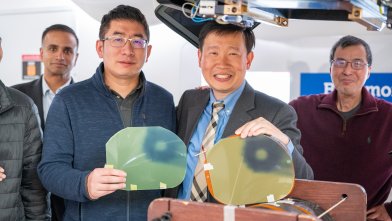Faster treatment and higher patient throughput
One of the most compelling advantages of DynamicARC is its ability to provide faster treatment.1,2 By doing so, DynamicARC can help proton therapy departments increase their patient throughput by 20 to 30%.3 Dr Steven emphasizes that this can help address bottlenecks in cancer treatment facilities that have patients on waiting lists. By increasing the number of patients treated on a proton therapy machine, healthcare systems have the potential to substantially improve their finances while ensuring that access to this advanced cancer treatment modality is improved for patients who need it.4
Robust target coverage with DynamicARC
DynamicARC is not only faster but also, as Dr. Stevens mentions, “more robust, which means we can use smaller margins”. Dr. Stevens points out that as the field evolves, DynamicARC is poised to “become the dominant form of intensity-modulated proton therapy (IMPT) within the next few years”, similar to the advancements seen in volumetric modulated arc therapy (VMAT) with X-rays. Rotational delivery of protons with DynamicARC can simplify treatment delivery workflows, as VMAT did compared to intensity-modulated radiotherapy (IMRT) in conventional radiotherapy.4
Improving Patient Outcomes with DynamicARC
Patients stand to benefit significantly from the advantages offered by DynamicARC. By providing sharper doses with better conformality, DynamicARC treatments can spare more healthy tissue surrounding tumors, which is crucial for reducing side effects and improving overall patient outcomes.4,5
Advancing Research and Development
DynamicARC also paves the way for further research and development in proton therapy. As Dr. Stevens explains, DynamicARC may “allow clinicians to strategically place high-LET protons in the middle of the tumor volumes, in contrast to standard IMPT today” potentially leading to improved treatment planning and better clinical outcomes.4 The ability to optimize linear energy transfer (LET) marks a significant advancement over standard IMPT, where high-LET protons tend to end up at the edge of the field, which may pose risks to normal tissues.4-6 The transition to this advanced treatment method signifies a significant step forward in cancer care, enabling clinicians to refine their approaches and adopt more effective strategies.
The Future of Proton Therapy
As the field continues to evolve, it is clear that DynamicARC may play a pivotal role in shaping the future of proton therapy. Dr. Stevens anticipates that “just as VMAT has transformed X-ray treatment, DynamicARC will quickly become the dominant form of IMPT within a few years” for the majority of patients receiving proton therapy. The combination of speed, precision, and improved patient care can make DynamicARC a vital advancement in the fight against cancer.
Discover how DynamicARC can transform the future of proton therapy here.
Notes
Disclaimer: The statements of the healthcare professional included in this testimonial reflect only his opinion and personal experience. They do not necessarily reflect the opinion of any institution with whom he is affiliated or IBA.
* DynamicARC is the registered brand of IBA’s Proton Arc therapy solution which is currently under research and development. DynamicARC will be available for sale when regulatory clearance is received. Due to a continuous research and development program, IBA reserves the right to make changes in design, technical descriptions, and specifications of its products without prior notice. Some features are under development and may be subject to review by competent authorities.
References
- Ding X et al. The first modeling of the spot-scanning proton arc (SPArc) delivery sequence and investigating its efficiency improvement. Int J Part Ther. 2022;8(4):97.
- Liu G et al. The First Modeling of the Spot-Scanning Proton Arc (SPArc) Delivery Sequence and Investigating its Efficiency Improvement in the Clinical Proton Treatment Workflow. Int J Radiat Oncol Biol Phys. 2021;111(3):e524.
- Liu G et al. Development of a standalone delivery sequence model for proton arc therapy. Med Phys. 2023. doi: 10.1002/mp.16879.
- Mein S, et al. Particle arc therapy: Status and potential. Radiother Oncol. 2024 Oct;199:110434. doi: 10.1016/j.radonc.2024.110434. Epub 2024 Jul 14. PMID: 39009306.
- de Jong B et al. Both S. Spot scanning proton arc therapy reduces toxicity in oropharyngeal cancer patients. Med Phys. 2023 Mar;50(3):1305-1317.
- Li X, Ding X, Zheng W, Liu G, Janssens G, Souris K, Barragán-Montero AM, Yan D, Stevens C, Kabolizadeh P. Linear Energy Transfer Incorporated Spot-Scanning Proton Arc Therapy Optimization: A Feasibility Study. Front Oncol. 2021 Jul 12;11:698537. doi: 10.3389/fonc.2021.698537. PMID: 34327139; PMCID: PMC8313436.




